Here’s a little tip that will make your arm day workouts significantly more effective:
The key to getting bigger biceps and triceps is to strengthen these muscles as much as possible. The best arm workouts for mass are the ones that make you stronger.
You can find countless arm workouts online, but most of them are all about “hammering” your biceps and triceps until they’re swollen, pumped, and sore. While this can feel gratifying (all those reps must be doing something, right?), it’s not the best way to build big arms.
That’s why the arms workouts in this article are different.
Not only are they scientifically proven to result in more muscle growth than the “big arms workouts” you’ll find elsewhere, they also take less time, and tend to be much more enjoyable.
Let’s get to the workouts!
Table of Contents
My Top 5 Tips for Better Arm Workouts
Before we get into the arm workout routines themselves, here are a few tips to help you get the most out of your arm training.
1. Use compound and isolation exercises to build bigger arms.
Many people think that isolation exercises like curls and triceps extensions are the best way to build arm mass, but research shows that compound exercises like the pull-up, chin-up, and close-grip bench press are actually more effective in this regard.
What’s more, studies show that adding arm isolation exercises like biceps curls and triceps extensions to a workout routine already includes compound exercises for these muscles only marginally improves arm muscle growth.
Arm isolation exercises can still have a place in your program, but you should put most of your energy into heavy compound exercises that train your arms.
2. Use heavy weights.
As a natural weightlifter, your number one goal should be getting stronger.
So long as you make that your primary focus in your training, you’ll have no trouble building big arms.
What’s the best way to get stronger?
Lift heavy.
And by “heavy,” I mean working primarily with weights in the range of 75 to 85% of your one-rep max (1RM), or in the range of 8 to 10 (~75%) to 4 to 6 (~85%) reps.
High-rep sets also have a place in your training, but the majority of your time should be spent training in these rep ranges—even when training arms.
3. Increase your weights over time.
If you stop getting stronger, you’ll eventually stop getting bigger.
That’s why you must make progressive overload the key focus of your arm workouts.
You can do all the fancy training techniques you want, but if you’re not adding weight to the bar (or dumbbells) over time, you’re going to struggle to gain muscle effectively.
4. Put just as much effort into training your triceps as your biceps.
Big biceps means big arms, right?
Not necessarily.
Ironically, the biceps contribute substantially less to overall arm size than the triceps, which are a much larger muscle group. For most people, well-developed triceps will account for anywhere from 50 to 70% of their overall arm size.
Thus, one of the little-known “secrets” to building big arms is building big triceps.
5. Use different exercises to train every portion of your biceps and triceps.
If you want to build big, proportional arms that look “filled out” properly, it’s smart to include a variety of different biceps and triceps exercises.
Research shows that varying the position of your shoulder and upper arm while you perform biceps and triceps exercises trains your arm muscles in different ways, helping you avoid muscle imbalances.
For example, instead of only training your biceps with standing barbell curls several times per week, try incline dumbbell curls (which place your upper arms behind your body) or preacher curls (which place your upper arms in front of your body) on several days.
And instead of only doing triceps pushdowns, try EZ Bar skullcrushers (which place your upper arms at 90 degrees relative to your body) or overhead dumbbell triceps extensions (which place your upper arms next to your head) in your program.
The Best All-Around Arm Workout
If you’re looking to add overall mass to your arms, this is the workout for you.
Close-Grip Bench Press: 3 sets of 4 to 6 reps
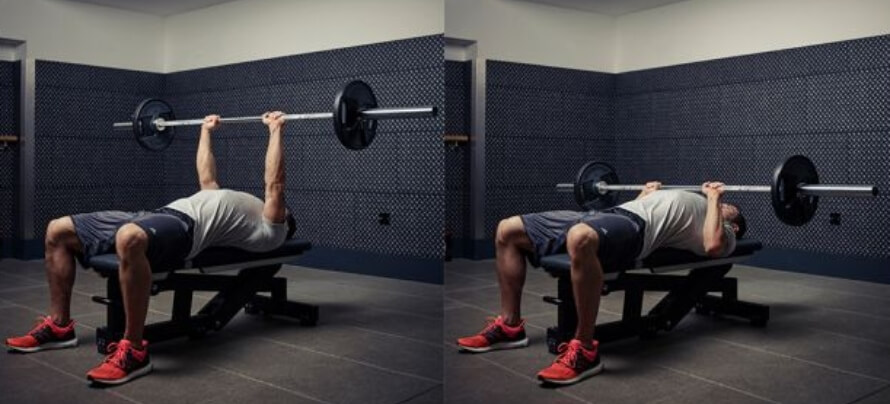
How to: Lie on a flat bench, pull your shoulder blades together and down, and without lifting your butt or shoulders off the bench, slightly arch your back. Grip the barbell with a shoulder-width grip or slightly narrower, and unrack the barbell.
Lower the barbell to your lower chest. When the bar touches your chest, explosively press the bar back to the starting position.
Why: The close-grip bench press is one of the best triceps exercises you can do because it allows you to use a lot of weight. It also trains your chest, shoulders, and biceps, making it an outstanding all-around upper-body exercise.
Pull-up: 3 sets of 4 to 6 reps
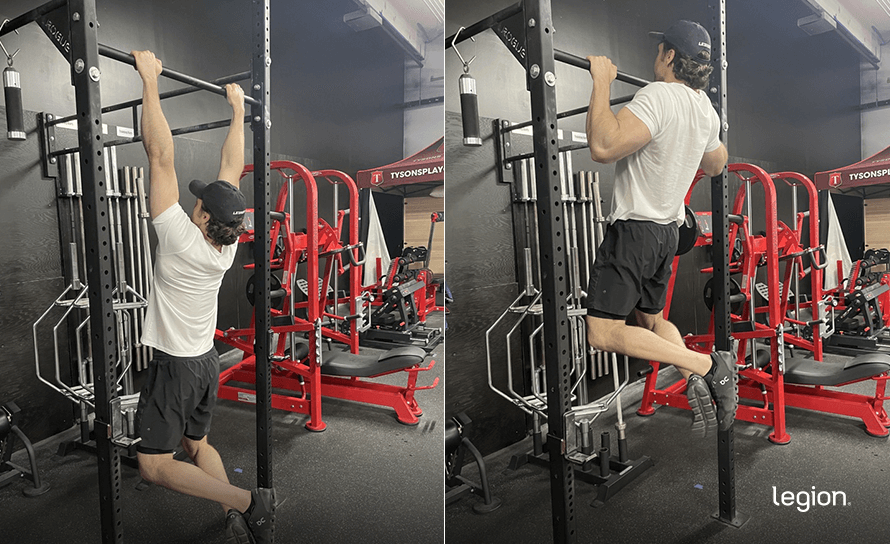
How to: Grab a pull-up bar with your palms slightly wider than shoulder-width apart and facing away from you and your arms straight. Pull your body upward until your chin rises above your hands, and then lower yourself to return to the starting position.
If you can do more than six reps with your body weight, add extra weight to the exercise by hanging a weight from a dip belt or pinching a dumbbell between your thighs to stay in the target rep range. If you can’t do four reps with your body weight, keep at it until you can. (Losing weight is often the best way to improve your pull-up strength).
Why: Research shows that vertical pulling exercises, like the pull-up, are great biceps builders, and they’re easier to load with heavy weights than biceps isolation exercises.
EZ Bar Skullcrusher: 3 sets of 8 to 10 reps
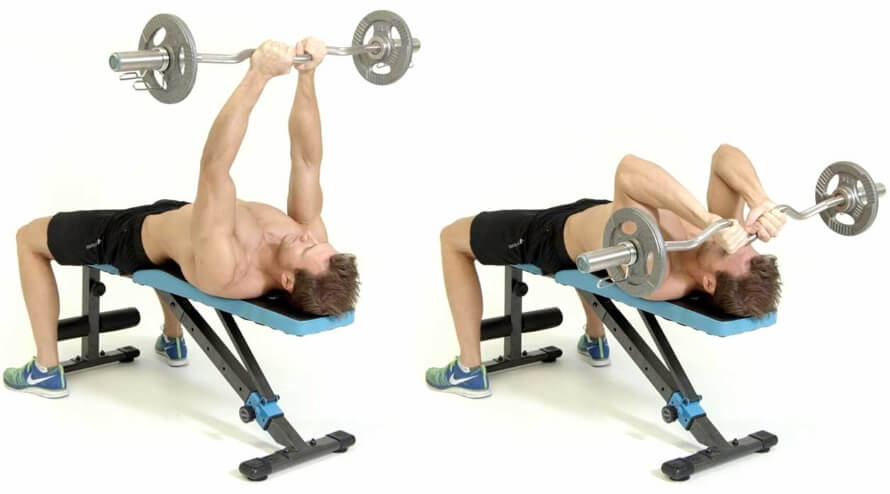
How to: While lying on a flat bench, hold an EZ Bar above your chest with a shoulder-width grip. Bend your elbows and lower the bar until it’s right above your forehead, and then reverse the movement to return to the starting position. (Tip: If you want to increase the range of motion of this exercise, lower the bar behind your head until it’s almost touching the bench.)
Why: The EZ bar skullcrusher is a great exercise for training the slightly smaller medial and lateral heads of the triceps, ensuring you have defined, proportional upper arms.
Barbell Curl: 3 sets of 8 to 10 reps
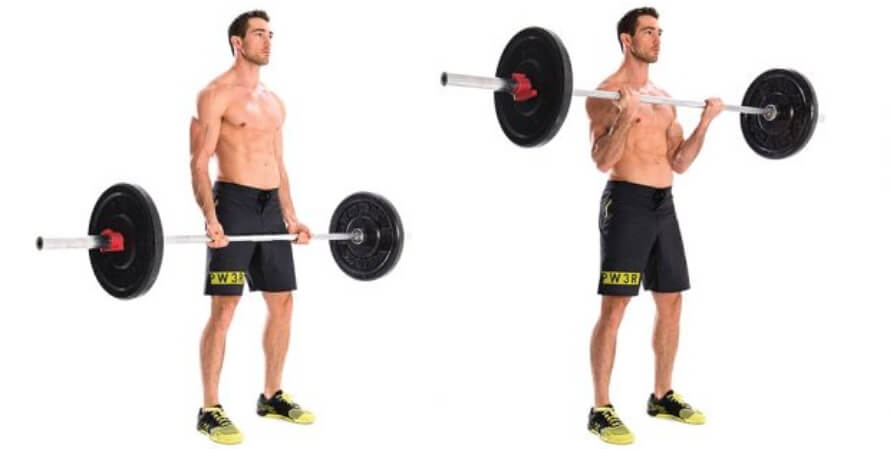
How to: While standing up straight, hold a barbell with your palms shoulder-width apart and facing away from you. Your arms should be straight and the bar should be resting against your thighs. Bring the bar up to shoulder height by bending at the elbow, and then lower it back to the starting position. (Tip: To make this exercise more challenging and effective, raise the bar up to eye level, allowing your upper arms to move forward, then lower it to the starting position).
Why: Biceps curls are the most effective isolation exercise for training your biceps, and using a barbell allows you to go as heavy as possible.
The Best Biceps Workout
This workout is perfect if you’re looking to add biceps mass and want to dedicate a whole day to just training your “bis.” After all, who doesn’t?
Chin-up: 3 sets of 4 to 6 reps
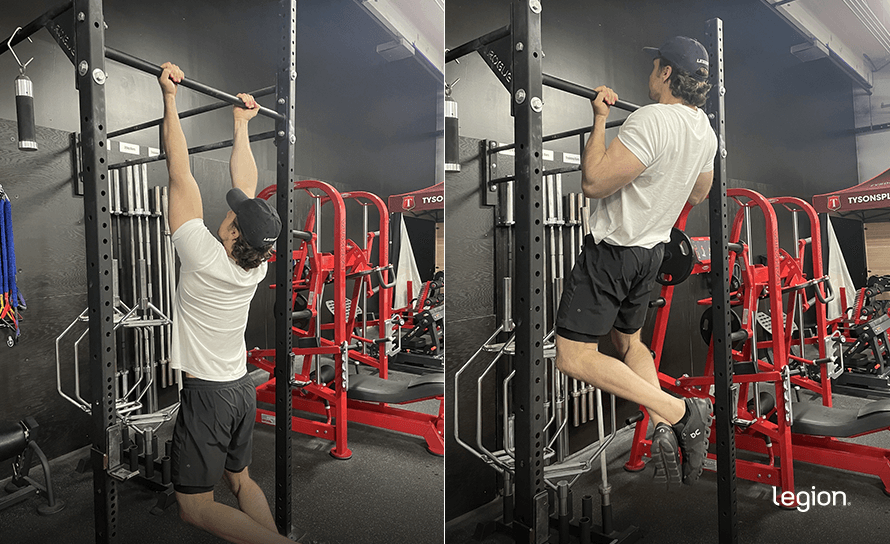
How to: Grab a pull-up bar with your palms shoulder-width apart and facing toward you and your arms straight. Pull your body upward until your chin rises above your hands, and then lower yourself to return to the starting position.
If you can do more than six reps with your body weight, add extra weight to the exercise by hanging a weight from a dip belt or pinching a dumbbell between your thighs to keep you in the target rep range. If you can’t do as many as four reps with your body weight, keep at it until you can. (Losing weight is often the best way to improve your pull-up strength).
Why: Research shows that vertical pulling exercises, like the chin-up, hit the biceps hard, and are easier to load with heavy weights than biceps isolation exercises.
EZ Bar Preacher Curl: 3 sets of 8 to 10 reps
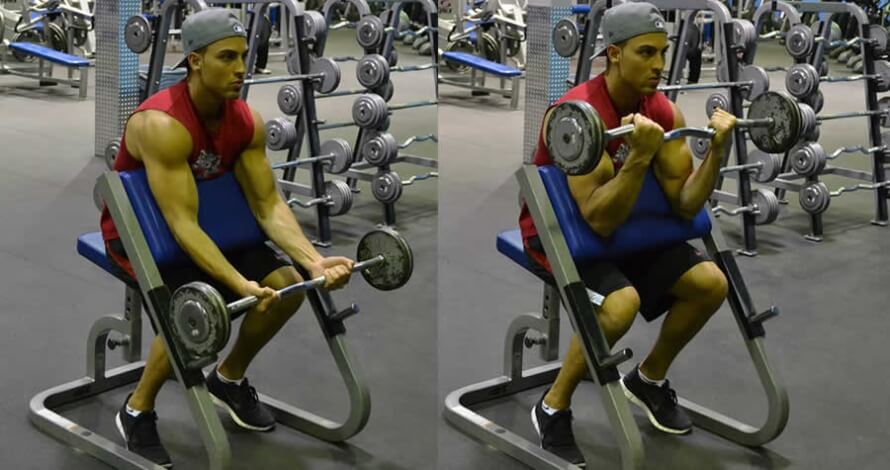
How to: Adjust a preacher curl station so that the top of the pad sits in your armpits while you’re sitting on the seat. Grab the EZ bar with a shoulder-width grip and your palms facing toward you.
Bring the bar up to shoulder height, making sure to keep your elbows on the pad. Lower the bar to return to the starting position.
Why: Preacher curls prevent you from “cheating” by swinging the weight to the top position. While this makes the exercise harder, it also ensures your biceps are doing most of the work.
Alternating Dumbbell Curl: 3 sets of 8 to 10 reps
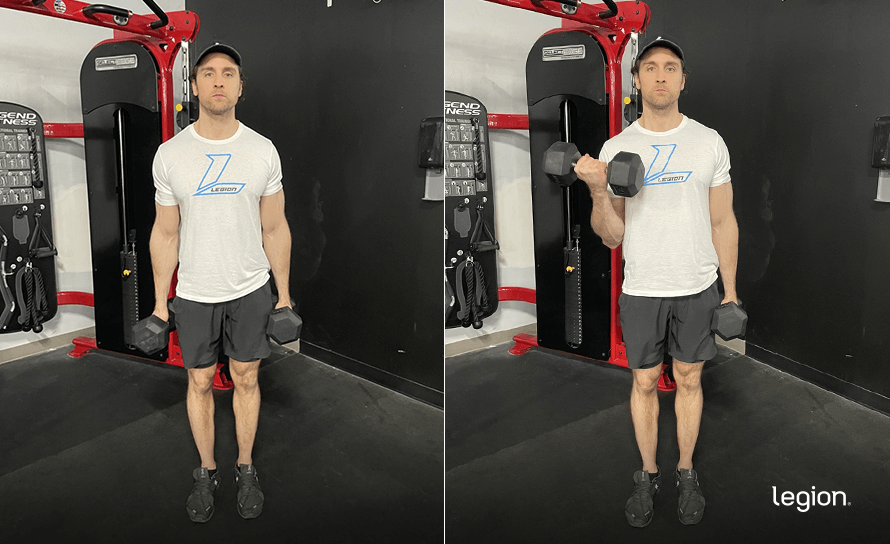
How to: Stand up straight holding a dumbbell in each hand, with your palms facing each other and your arms hanging straight at your sides.
Keeping your left arm at your side, flex your right arm and curl the dumbbell up until it’s in front of your right shoulder. As you lift the dumbbell, rotate your wrist so that your palm is facing toward your shoulder at the top of the rep. Lower the dumbbell to the starting position, and repeat with your left arm.
Why: Alternating dumbbell curls allow you to train each arm independently, which helps prevent one arm from getting bigger or stronger than the other.
Hammer Curl: 3 sets of 8 to 10 reps
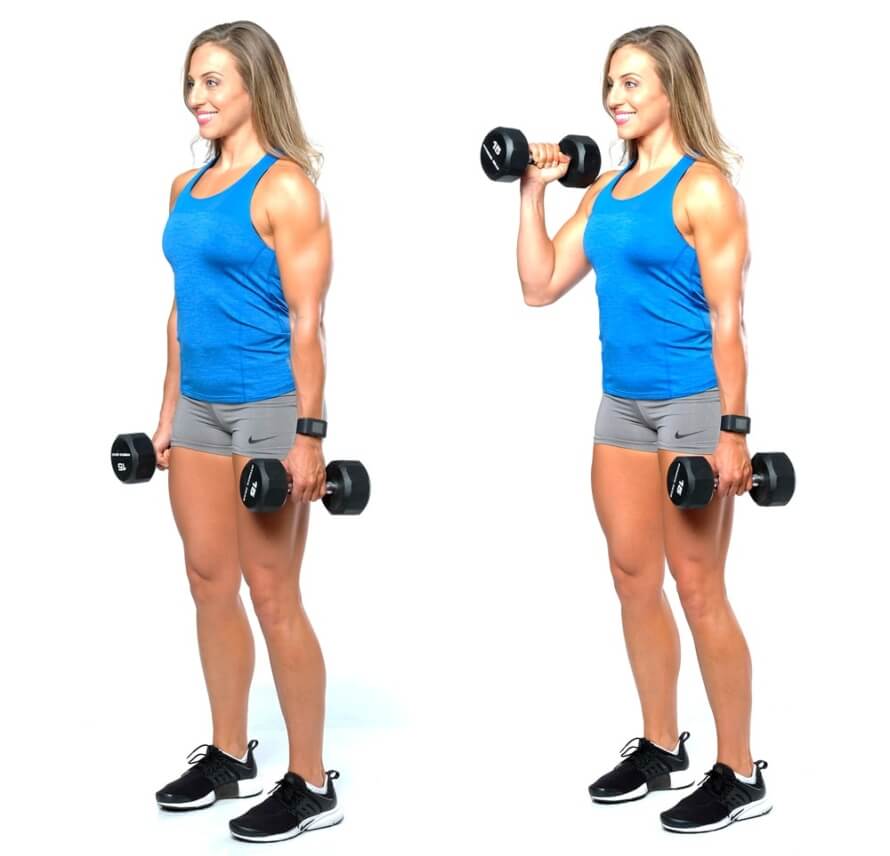
How to: Stand up straight holding a dumbbell in each hand, with your palms facing each other and your arms hanging straight at your sides.
Keeping your left arm at your side, curl your right arm to bring the dumbbell upward until it’s in front of your right shoulder. Keep your thumb pointing toward the ceiling during the entire rep (don’t rotate your wrist). Lower the dumbbell to the starting position, and repeat with your left arm.
Why: The hammer curl emphasizes the brachialis—a small muscle that can help to push up the biceps brachii—making your upper arms look bigger and improving your biceps “peak.”
The Best Tricep Workout
If you want to train your triceps more than your biceps or you’re already giving your biceps plenty of attention, try this triceps-focused arm workout routine.
Close-Grip Bench Press: 3 sets of 4 to 6 reps
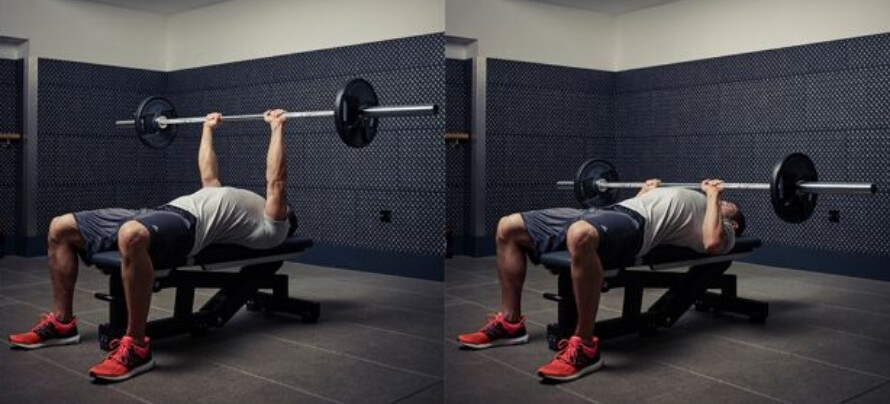
How to: Lie on a flat bench, pull your shoulder blades together and down, and without lifting your butt or shoulders off the bench, slightly arch your back. Grip the barbell with a shoulder-width grip or slightly narrower, and unrack the barbell.
Lower the barbell to your lower chest. When the bar touches your chest, explosively press the bar back to the starting position.
Why: The close-grip bench press is one of the best triceps exercises you can do because it allows you to use a lot of weight. It also trains your chest, shoulders, and biceps, making it an outstanding all-around upper-body exercise.
EZ Bar Skullcrusher: 3 sets of 8 to 10 reps
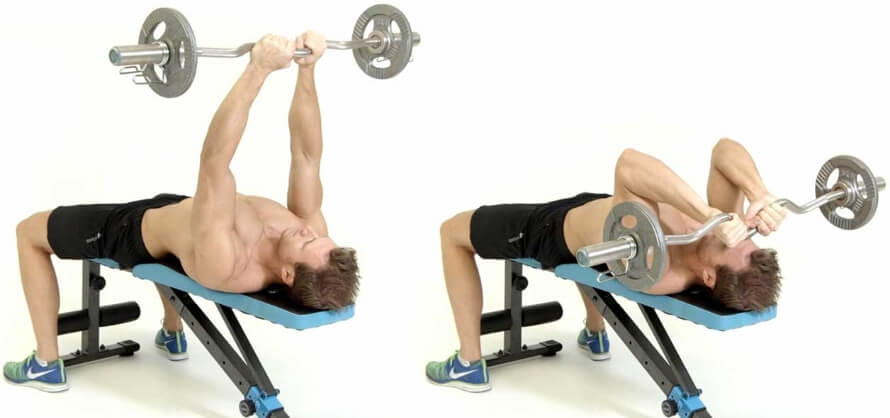
How to: While lying on a flat bench, hold an EZ Bar above your chest with a shoulder-width grip. Bend your elbows and lower the bar until it’s right above your forehead, and then reverse the movement to return to the starting position. (Tip: If you want to increase the range of motion of this exercise, lower the bar behind your head until it’s almost touching the bench.)
Why: The EZ bar skullcrusher is a great exercise for training the slightly smaller medial and lateral heads of the triceps, ensuring you have defined, proportional upper arms.
Dumbbell Overhead Triceps Extension: 3 sets of 8 to 10 reps
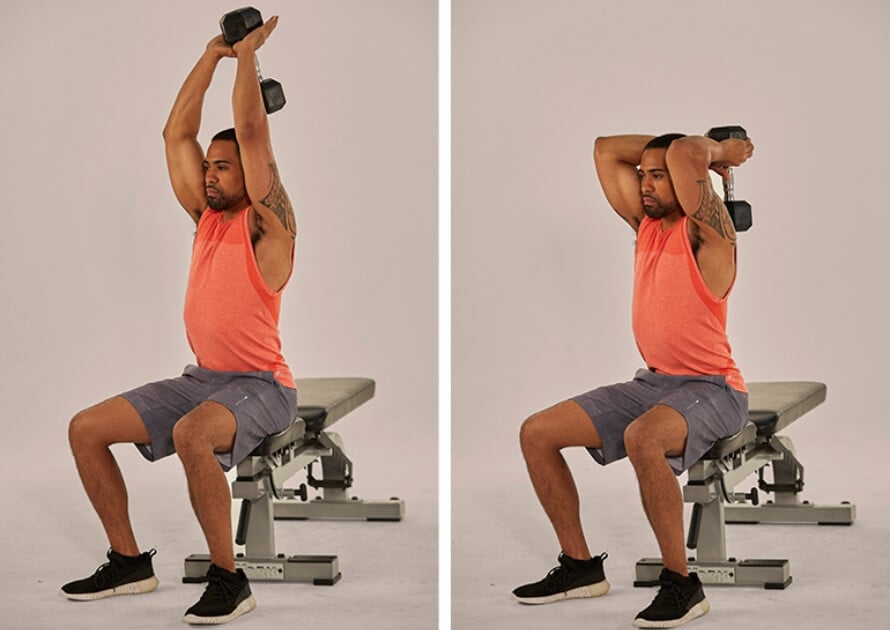
How to: Grab a dumbbell and sit a bench with the backrest adjusted so it’s nearly vertical. Extend your arms to push the dumbbell over your head, giving it a little nudge with a thigh if needed. Adjust your grip so your palms are supporting the weight of the dumbbell and are pointing toward the ceiling. Lower the dumbbell behind your head until your elbows are at a 90-degree angle, then extend your arms to return to the starting position.
Why: Like the skullcrusher, the dumbbell overhead triceps extension is an excellent exercise for training the slightly smaller medial and lateral heads of the triceps.
Cable Triceps Pressdown: 3 sets of 8 to 10 reps
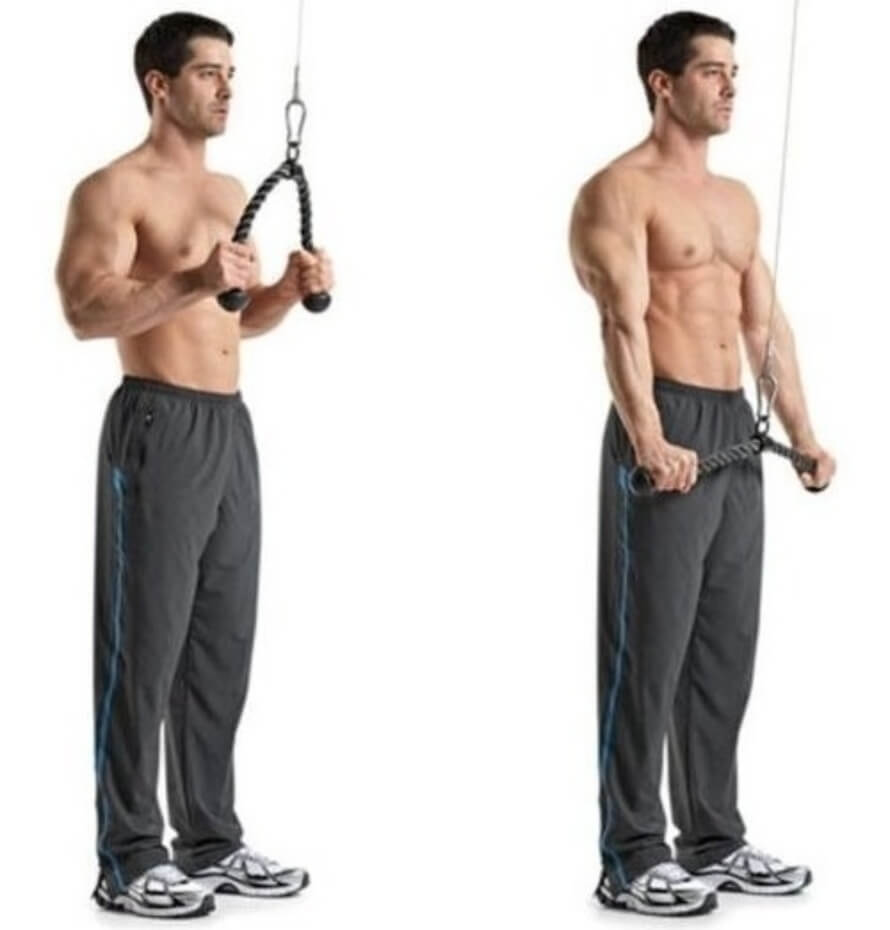
How to: Set the pulley on a cable machine to slightly above head height, and attach the rope handle. Stand upright or lean slightly forward (you can adopt a staggered stance if it helps you balance), grab one end of the rope in each hand, and push the rope downward by straightening your elbows. Once your arms are straight and at your sides, reverse the motion to return to the starting position.
Why: The cable triceps pushdown is particularly good for emphasizing the long head of the triceps. The long head is also the largest of the three sections of the triceps, and so training this portion of your triceps will have the biggest impact on your upper arm size.
FAQ #1: How many times should I train arms per week?
One dedicated arm workout per week is enough for most people.
Remember that your triceps are heavily involved in any pressing exercises you do, like bench and overhead press, and your biceps are trained in your pulling exercises, particularly pull-ups and chin-ups.
This means if you’re following a good strength training program, you’re already training your arms as a consequence of doing lots of heavy, compound weightlifting.
If you want to add some extra mass to your arms (and who doesn’t?), though, doing one arm day workout like the ones we’ve talked about in this article should do the trick.
FAQ #2: What’s the best way to train arms at home?
You can definitely build big arms at home, you just need to prioritize the correct exercises.
For triceps, the best exercises you can do are close-grip push-ups, bodyweight dips, and triceps “bench” dips.
For biceps, stick to pull-ups, chin-ups, and bodyweight rows.
Also, if you can get your hands on a set of adjustable dumbbells or exercise bands, you can add a lot more variety to your workouts, and make them significantly more challenging, enjoyable, and productive.
If you want to learn more about building muscle with home workouts, check out this article:
The Best Home Workout Routines for When You Can’t Go to the Gym
FAQ #3: What’s the best diet for building bigger arms?
In order to maximize muscle and strength gain, you need to maintain a mild calorie surplus.
That is, you need to eat about 110% of your total daily energy expenditure (TDEE) every day.
The reason for this is a calorie surplus optimizes your body’s “muscle-building machinery,” so to speak, greatly enhancing your body’s ability to recover from and positively adapt to your training.
That’s not all, though—you need to eat enough protein to allow your muscles to recover, repair, and grow effectively, too.
If you want to learn exactly how much protein you need to eat to build mass, check out this article:
How Much Protein Do I Need? The Definitive (and Science-Based) Answer
+ Scientific References
- Kholinne, Erica, et al. “The Different Role of Each Head of the Triceps Brachii Muscle in Elbow Extension.” Acta Orthopaedica et Traumatologica Turcica, vol. 52, no. 3, 1 May 2018, pp. 201–205, www.ncbi.nlm.nih.gov/pmc/articles/PMC6136322/, https://doi.org/10.1016/j.aott.2018.02.005.
- Gentil, Paulo, et al. “Single vs. Multi-Joint Resistance Exercises: Effects on Muscle Strength and Hypertrophy.” Asian Journal of Sports Medicine, vol. 6, no. 1, 22 Mar. 2015, www.ncbi.nlm.nih.gov/pmc/articles/PMC4592763/, https://doi.org/10.5812/asjsm.24057.
- Youdas, James W, et al. “Surface Electromyographic Activation Patterns and Elbow Joint Motion during a Pull-Up, Chin-Up, or Perfect-PullupTM Rotational Exercise.” Journal of Strength and Conditioning Research, vol. 24, no. 12, Dec. 2010, pp. 3404–3414, https://doi.org/10.1519/jsc.0b013e3181f1598c.
- de França, Henrique Silvestre, et al. “The Effects of Adding Single-Joint Exercises to a Multi-Joint Exercise Resistance Training Program on Upper Body Muscle Strength and Size in Trained Men.” Applied Physiology, Nutrition, and Metabolism, vol. 40, no. 8, Aug. 2015, pp. 822–826, https://doi.org/10.1139/apnm-2015-0109.
- Oliveira, Liliam F., et al. “Effect of the Shoulder Position on the Biceps Brachii Emg in Different Dumbbell Curls.” Journal of Sports Science & Medicine, vol. 8, no. 1, 1 Mar. 2009, pp. 24–29, www.ncbi.nlm.nih.gov/pmc/articles/PMC3737788/.
- Stokes, Tanner, et al. “Recent Perspectives Regarding the Role of Dietary Protein for the Promotion of Muscle Hypertrophy with Resistance Exercise Training.” Nutrients, vol. 10, no. 2, 7 Feb. 2018, p. 180, www.mdpi.com/2072-6643/10/2/180/pdf, https://doi.org/10.3390/nu10020180.
- Eckerson, Joan M., et al. “Effect of Creatine Phosphate Supplementation on Anaerobic Working Capacity and Body Weight after Two and Six Days of Loading in Men and Women.” The Journal of Strength and Conditioning Research, vol. 19, no. 4, 2005, p. 756, https://doi.org/10.1519/r-16924.1.
- Bassit, Reinaldo Abunasser, et al. “Effect of Short-Term Creatine Supplementation on Markers of Skeletal Muscle Damage after Strenuous Contractile Activity.” European Journal of Applied Physiology, vol. 108, no. 5, 3 Dec. 2009, pp. 945–955, https://doi.org/10.1007/s00421-009-1305-1.











